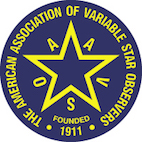YSO
Alert Notice 710: Monitoring requested for UXOR ASASSN-V J181654.06-202117.6
Note: This campaign has been concluded as of 28 October 2020, BUT a new campaign from the SAME ASTRONOMER requesting coverage of the SAME TARGET is announced in AAVSO Alert Notice 723. - Elizabeth O. Waagen, 28 October 2020
July 14, 2020
Alert Notice 693: V582 Mon monitoring requested
January 24, 2020
AAVSO Forum threads (scroll to the bottom of a thread for latest posts):
- Campaigns and Observing Reports: https://www.aavso.org/v582-mon-campaign-2020
- Young Stellar Objects: https://www.aavso.org/v582-mon-campaign-2020-01
Alert Notice 641: V1490 Cyg multiwavelength campaign
July 24, 2018: Dr. Dirk Froebrich (University of Kent) has requested AAVSO observations to support their upcoming observations of V1490 Cyg. He writes:
"Background: We have recently discovered that the young star V1490 Cyg (situated in the Pelican Nebula IC 5070) is periodically occulted by material in its circumstellar disk(*). Our light-curves indicate a period of about 32 days, and the obscurations are comparable to UX-Ori type eclipses.
Alert Notice 621: Optical monitoring of NSV 24045 = HD 163296
March 15, 2018: Evan A. Rich (Ph.D. candidate, University of Oklahoma), and Drs. John Wisniewski (University of Oklahoma), John Tobin (University of Oklahoma), Carol Grady (Goddard Space Flight Center), and Mike Sitko (University of Cincinnati) have requested AAVSO assistance in monitoring the bright (6.9 V) Young Stellar Object NSV 24045 (HD 163296) from now through September 2018.
Alert Notice 590: V1117 Her observations requested
Note: Continuing monitoring of V1117 Her is requested until further notice. - Elizabeth O. Waagen, 17 April 2020
August 7, 2017: AAVSO Young Stellar Object (YSO) Section leader Michael Poxon (Great Plumstead, Norfolk, UK) requests coverage of the YSO V1117 Her.
Alert Notice 574: Monitoring of EPIC 204278916 requested
April 25, 2017: Dr. Carlo Manara (ESA Science and Technology SCI-S, the Netherlands) and colleagues have requested AAVSO assistance in monitoring the young, disk-bearing low-mass (M type) pre-main-sequence star EPIC 204278916 (2MASS J16020757-2257467).
The YSO Zoo
...and welcome to the Zoo!
Part of the reason why a YSO section is needed is to try and make some sense of how the different types of variable star fit into some sort of scheme. Should we view the various types as distinct, or should we look at behaviour instead? Pursuing the zoo theme for a while, how do the various types of YSO fit into the interstellar ecosystem?
The What and Why of YSO's!
This page will present a brief introduction to Young Stellar Objects and Star Formation. What it is and why we are so darn interested by the whole thing - and what we, as amateur astronomers, can do in helping to discover more about the amazing, violent processes that are going on, as you read this, in deepest space (at least that's what most of us are; apologies to you lucky visitors who actually get paid for doing astronomy)


